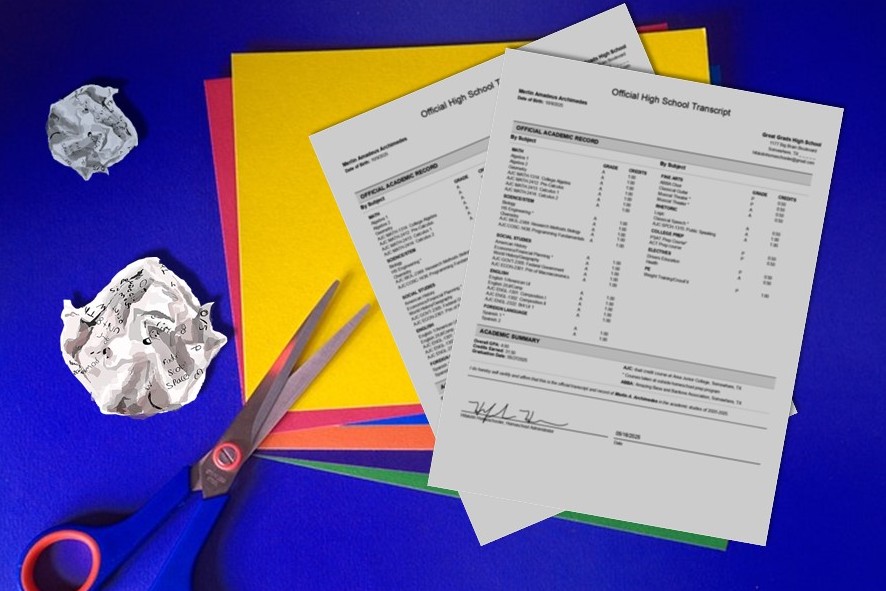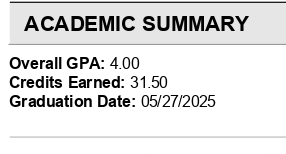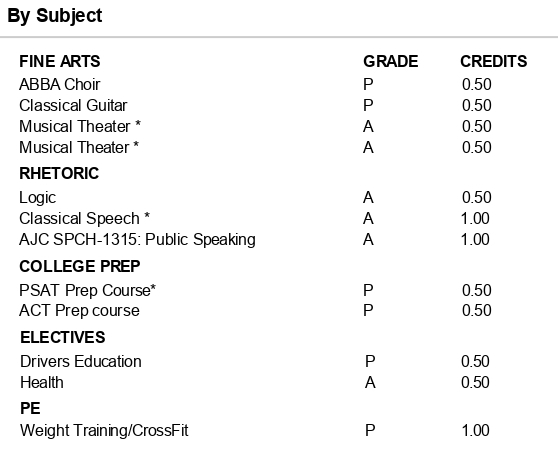You’ve likely come here in a panic because your kid needs a transcript yesterday. Or you are nearing the giant chasm between homeschooling the “forgiving years” and stepping off into high school. The perceived point-of-no-return and transcripts….AHH! Or you’ve been delaying the task or struggling along with…
Homeschool transcript anxiety.
If you need to see my sample transcript right now before you chew your nails off. Hurry click here! I get it. I’ve stood at the very same homeschool chasm and whimpered.

But go ahead and jump with faith that God will provide and others are just being dramatic. The irrational fear of making a transcript is because parents see it as a one-page report of their own success. It simply must be perfect! Or else… it becomes a confession of failure on parchment (possibly the parchment paper you tried to produce in a failed history lesson that ended in boredom and mess).
Oh stop!
Transcripts are one of the simplest tasks you’ll do while homeschooling high school. Now, if you want to get together and cry over the struggle to get them out of bed before 11am or getting yourself psyched to check their math, I’ll bring the scones. You brew the coffee. But don’t lose anymore hair and good fun reading time over the simple task of a transcript. Except to finish the fun and helpful article.
The Small Significance of a Transcript
Admittedly, I never really stressed about making a transcript. Maybe it was naïve ignorance or my inner Scarlett Ohara saying “I’m not going to worry about that today. I’ll worry about that tomorrow.” while homeschooling three boys before we reached the high school years.
Also, I remembered my own high school transcript and I was less than impressed by its simplicity.
After 4 years of honors classes, assignments, projects, tests, efforts to stay on the honor roll and top the class ranks, choosing the best electives and extracurricular activities, test prep, AP credits, volunteering, fundraising, all the academic and emotional stress….
That was it! One simple 8 ½ X 11 sheet of paper with the school letterhead, some course titles, letter grades, three digits and a decimal. That summed me up?
Did these people even know me? I had gone to the same school since Kindergarten. I had left skin on the metal slides (literally). I’d attempted running track, tooted a clarinet, danced/marched/cheered, and won Miss Congeniality on the football field. I had won all kinds of academic awards, been inducted into the honor’s society, and an officer for the drill team upon the auditorium stage.
All that living and learning to play the game to make it in “the real world” HA! was reduced to one flammable page of course titles and a GPA.
The Even Smaller Significance of a Homeschool Transcript
Guess what?
The same impersonal information that is included on public school transcripts is expected of the homeschool transcript. Extra embellishments may be seen as unprofessional and less credible.
The information provided on a homeschool transcript may be seen as even less significant to the application process for some endeavors simply because grades were calculated and recorded by “biased parents.” Skeptical eyes will be searching for mom’s embellishments.
No sweat. There are other areas to highlight your kid’s unique homeschool journey and its support of their stated GPA. These include a homeschool resume or portfolio that can include events, experiences, awards, and work samples. There are college application questionnaires and essays to elaborate on your student’s wit and ability. Plus, in-person interviews will also showcase your amazingly sociable and intelligent homeschooler. (Get the book: Socialize Like a Homeschooler!)
Making an effective transcript was just not a big deal before or in hindsight of graduating our first two now happily tucked away at the university of their choice. And you should stop making a big deal about it too because… The high school transcript is one small sticky note on life’s lengthy timeline that will only be relevant for a couple of years at most.
Parents, do you know where your own high school transcript is right now? Or why you took typing in 10th grade when your 1st grader could probably log into a NASA satellite from your cellphone? After the gap between high school graduation and your kid’s next adventure is bridged with a combination of transcripts, test scores, interview and essays, the transcript will become irrelevant. Your homemade transcript will be forgotten faster than the greeting card holding a cash gift once their next adventures begin.
Don’t let it monopolize the last wonderful moments of your homeschool journey. Besides, a superbly organized and unique resume will trump the transcript’s importance quickly and exponentially. Skills and experiences will outweigh forgotten course titles and letter grades.
Early on I decided if I could relearn Algebra for these boys, I could certainly wing a convincing one-page document. In fact, I’m a creative type. I would make an appealing transcript to help my guys stand out in review for admissions! (rolls up sleeves “How do I love thee, let me count the unit studies…) I could colorfully depict the real heart in each of them. All their achievements, struggles, hurtles, goals, spiritual battles, favorite authors, and most loved snacks at read-aloud time.
But wait! STOP!
No one reviewing this transcript needs to know how your kid learned; only what they learned. Give them this information in an easy to scan, one-page, no frills document. They will quickly look over it and shove it into a ranked category of applicants.
I know it’s hard to hold back. You want whoever looks at the transcript to see the amazing person you have raised. But you want your student to stand out, not your paper project. Don’t let your amazing child be dismissed as a homeschooler and not taken seriously because mom’s transcript looks like a dinky “vote for Pedro” flyer.

1. Use a simple standard format.
Obviously, once you start reflecting on your student’s courses and your own educational prowess, you’ll want to show it off on the transcript. You might imagine using special paper with a studious patina, special characters, fonts, and elaborate graphics. Maybe even confetti that bursts forth when it’s unsealed at the university of choice!
Do not be artsy and crafty! You do not want your homeschooled kid to stand out in this manner. You want to fly under the homeschool radar!

Simple Format Checks:
-
-
-
- Use a simple standard black font and simple bullet points as needed, bold only headings and pertinent info, and do not use graphics or emojis.
- Print copies for submission on quality white paper with a simple heading.
- Include a title (ex. High School Transcript) and the name of your school ( ex. Creekside Christian High School) and address in your heading. If using a school emblem/logo, keep it small and tasteful.
- Provide student’s full name, address, birth date, years attended high school (ex. Years attended: 2020-2023) at the top of the page.
- List the number of course credits earned and the student’s GPA prominently. (*more on calculating these items in the next sections)
- List all high school courses taken and the number of credits per course by grade level or subject area format. (In my opinion, subject format is best for most homeschoolers. Keep reading to find out why…)
- Use special characters, asterisks, or acronyms to denote any important related info. Provide a legend at the bottom of the transcript to clearly reference their meanings.
(ex. an * placed beside all courses taken at a co-op; or ** for dual credit) - List all dual credit college courses with the title and complete course number given by the college and reference these in your legend as well. (ex. AJC-ENG1034: English Composition I)
-
-
2. Organize courses by subject to make it simple to scan for specific details.
It is certainly an option to list courses by grade level, as most schools do. However, I believe it is in a homeschoolers best interest to list their course work by subject area.
Why?
-
-
- It is easier to scan a transcript and get a quick overview of a student’s work/knowledge base when courses are organized by subject. For example, if admissions counselors want to know how far your student (who wants to major in engineering) has gone in math, they can quickly go to the math section and see that he or she has completed a study of Algebra I through Calculus II.
-
-
-
- The educational calendar and extra course work homeschoolers complete does not often fit precisely into 4 grade levels. Schools expect students to take a basic set of courses and electives neatly packaged in grade levels between summer breaks. But homeschoolers are free to make their own plans overriding traditional educational calendars, and those plans aren’t so clear cut. Some kids complete high school level work in the 8th grade. Others may complete two science courses in one year, spread a single course over two years, or even do extra courses over the summer. If all these extra credits are forced into a grade level organization, it can appear fantastical, and gap-ridden and draw unwanted scrutiny.
-
-
-
- Unique areas of study are easily highlighted. Listing courses by subject can be a subtle homeschool brag, without negative attention. For example, under a subject area heading such as skills training courses, you can list courses in woodworking, flight training, CPR certification, welding apprenticeship, etc. These can be given a grade or a simple (P) for pass. Including these areas of study gives a quick glance at what makes your student stand out. And a hint to what amazing-ness is likely detailed in their resumes and essays.
-
3. Use simple course titles.
If your kid studied exotic plants and animals of the rain forests for a semester, call it biology or botany. Do not create an enticing title like Venus Fly Trapping for Beginning Jungle Adventurers. This is homeschool weirdness and stupid and gives homeschoolers a bad rap. Creative titles are not seen as advanced, but rather a dinky summer camp trying to pass itself off as a high school science credit.
Remember, your audience is looking for specific points. Don’t get artsy or poetic.
Keep the title of courses clear, concise, and recognizable. Admissions counselors are going to scan this document for certain items they should easily identify.
Our recently graduated twins have transcripts bursting with individualism. And though the essence of homeschooling wafts from the pages, they were clearly and simply stated in acceptable mainstream terms: Chemistry, English, Algebra II, P.E., Computer Programming, Intro to Engineering, Flight Training Ground School, ACT Test Prep, etc. Though I was prepared, we were never questioned about their course work, what curriculum we used, or asked for proof of meeting any standards.
4. Use letter grades and an unweighted GPA.
For simplification and less questioning of credibility, I suggest listing a letter grade instead of a (mostly subjective) number grade for each course. After all, this is what colleges and universities use. Because what is the difference between a 92 and a 97 when calculating a GPA on an unweighted 4.0 scale?
Nothing. It’s an A.
-
-
- Assign each course a simple letter grade you calculate from their work/tests. Use a standard grade scale: A = (90-100), B= (80-89), C=(70-79), D=(Doesn’t matter. You’re not seriously going to include a course your kid did this poorly on, are you? Leave it out or redo the course entirely.) F= (Foolish failure to read the previous letter description)
You can assign a (P) for pass on elective work or courses that do not include graded assignments/tests (ex. P.E., choir, flight training). (More Hifalutin thoughts on grades)
- Assign each course a simple letter grade you calculate from their work/tests. Use a standard grade scale: A = (90-100), B= (80-89), C=(70-79), D=(Doesn’t matter. You’re not seriously going to include a course your kid did this poorly on, are you? Leave it out or redo the course entirely.) F= (Foolish failure to read the previous letter description)
-
-
-
- Calculate your student’s GPA using these simple letter grades. Assign a grade point number to each letter grade: A=4.0, B=3.0, C=2.0, D=(Dude, don’t make me repeat the above section!) F=(why are you reading this) Then, add all the grade point numbers and divide by the total number of courses you assigned a grade. Do not include courses marked (P) for pass in the total. BOOM! You have a GPA.
- Add up the total number of course credits earned and list this near the GPA and date of graduation.
- Calculate your student’s GPA using these simple letter grades. Assign a grade point number to each letter grade: A=4.0, B=3.0, C=2.0, D=(Dude, don’t make me repeat the above section!) F=(why are you reading this) Then, add all the grade point numbers and divide by the total number of courses you assigned a grade. Do not include courses marked (P) for pass in the total. BOOM! You have a GPA.
-
-
-
- Use an unweighted scale. It is tempting to use a weighted scale for proof your child completed what you know to be honors work. However, it is often more effective to stay humble and let their accomplishments speak for themselves through their resume, interview, portfolio, and/or standardized test scores.
-
-
-
-
- Listing courses as honors on a homeschool transcript can bring extra scrutiny and paperwork onto the backs of homeschool parents. You may be asked to list detailed descriptions of all activities, assignments, testing (both at home and expected outside testing), plus professional references, and ISBNs on all materials used for proof that still may not suffice.
-
-
-
-
-
- The validity and rigor of your homemade homeschool honors studies is difficult to prove to a skeptical admissions office, and many schools will ask you to resubmit it with an unweighted GPA. Sadly, much of what makes homeschool study more than honors work is not easily quantifiable on a transcript or course description.
-
-
Per the Texas Education Agency’s website, Texas requires between 22 and 26 credits for high school graduation. Because of the time and freedom homeschool provided us and the option of dual credit courses, my twins each earned over 31 credits on their high school transcripts.
Simultaneously, they each also earned 60 college credits and an Associates of Science degree. However, their community college transcripts were not utilized in their university admissions process.
As you might deduce, they completed honors work on steroids, but we humbly used an unweighted 4.0 GPA scale on our homeschool transcript. We listed only the courses we felt were pertinent to the high school portion of their graduation with a simple letter grade. We noted those courses taken from an outside source, homeschool group, or as dual credit using a simple key and legend.
The simple objective information contained in the homeschool transcripts conveyed their completed studies and knowledge base effectively. And when the transcripts were viewed alongside their resumes, essays, and **ACT test scores, no glitter explosion was necessary for them to shine. Their collective resumes spoke of a pilot’s license, multiple CAP honors including a Spaatz award, national homeschool honors society, science fair achievements, and the honor of being selected as homeschool graduate speaker in Austin, TX.
My two sons’ homeschool transcripts were accepted without question or request for further details at 5 different universities, both public and private. My guys were accepted at all 5 universities with academic scholarship offers.
Of course, I brag. But also, to show you that the transcript is but a simple doable piece of a bigger project. The transcript is the easy part. So, keep it simple and it will be more effective.
Confession: I did not create our transcripts from scratch. I was homeschooling high school for the first time with twins! Also, I have three boys with multiple activities and loads of laundry. Plus, we like to eat, and their little brother hates math. And so, with those hurdles and time constraints, and my worry over evaporating computer files, I chose to utilize and store our transcripts through HSLDA’s transcript service.
I bought a family subscription at the beginning of my twins’ freshman year. All our kids’ academics are now documented, neatly stored, and forever editable there for a yearly price. They also have individual kid pricing. The program is straight forward and simple to use and everything is continuously editable. Even after they’ve graduated. It’s your transcript do what you will with it. And for a little extra money, they’ll even send your printed or digital official, sealed, and fancy transcript directly to universities on your behalf.
Obviously, this service is not necessary to keep great records or to submit the transcript to schools. You can do this on your own, in writing, on a computer, with a template, or from your own design. HSLDA also has free templates for members to download. As do a host of other bloggers and sites on the web. Just be sure you have a backup system to save your records.
FYI: It is best if you update the transcript as you go because senior year will be crazy anyway. Trying to go back and remember all the things your student did, and the letter grade, will be exceedingly difficult and time consuming. And painful. Add completed courses and letter grades each semester/year as you finish them. Early in the senior year, add courses in progress to foreshadow the final document when sending it out to colleges and scholarship opportunities. You will send the finalized transcript after graduation to complete the admissions process.
- Use a simple standard format.
- Do not be artsy and crafty! You want to fly under the homeschool radar!
- You can start from scratch or use a template or online transcript service.
- Add a title (ex. High School Transcript) and heading including your homeschool’s name and address, optional tasteful logo, student’s name, D.O.B., and years attended.
- Organize courses by subject, not grade level, to make scanning for achievement simple.
- Use simple straightforward course titles.
- Keep the title of courses clear, concise, and easy to identify.
- Use simple letter grades and an unweighted GPA.
- Note courses taken from an outside source or other important info using special characters defined in a key at the bottom of the transcript.
- Making a transcript is one of the simplest tasks to do while homeschooling high school.
- The transcript for all high school grads is simply an impersonal list of courses, letter grades, and a GPA for a quick academic overview.
- The transcript is meant to show only what your kid learned; not how they learned it.
- The high school transcript will only be relevant for a couple of years at most.
- Your student’s portfolio or resume of experience, skills, and achievements is their place to standout and back-up the knowledge base and GPA claimed in the transcript.
- Their resume of accomplishments will supersede the transcript in importance rapidly.
- Don’t waste anymore precious time worrying over this one-page, soon-to-be irrelevant document. You can do it!
Click for a closer look at these sample transcript elements:





















